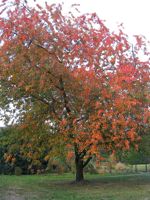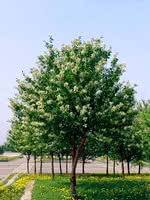Mon-Fri 9am - 5pm Mountain time
Black Cherry vs Klondike Amur Cherry
Prunus serotina
Prunus maackii Jefdike
NOT AVAILABLE THIS SEASON - MIGHT RETURN
NOT AVAILABLE THIS SEASON - MIGHT RETURN
Black Cherry is common in eastern North America but a rare find elsewhere. This tree is shade tolerant and is often found in old fields, forest openings, and along fencerows.
The fruit is edible and is commonly used to flavor rum and brandy. It is also edible and often eaten fresh or used in wine or jelly. Black Cherry trees typically begin producing fruit when they are 10 years of age.
Black Cherry wood is a rich reddish-brown color and is strong, making it valued in cabinetry and woodworking. It is often used in reclamation as well.
The leaves can poison livestock as they contain cyanide derivatives and precursors. However, many have noted that deer still seem to browse their trees with impunity and birds and other animals eat the fruit when available.
The Klondike Amur Cherry is an attractive cultivar which features showy, peeling gold bark and textured oval leaves that turn bright yellow in fall. It blooms with fragrant white flowers in mid spring, and produces tiny, tart black berries through the summer. The Klondike Amur Cherry was bred to have improved stem strength and stronger branching.
This tree makes a great addition to urban gardens and commercial planting, and is immune to black knot.
Black Cherry Quick Facts
Klondike Amur Cherry Quick Facts
Toxicity: bark and wilted leaves toxic to livestock

